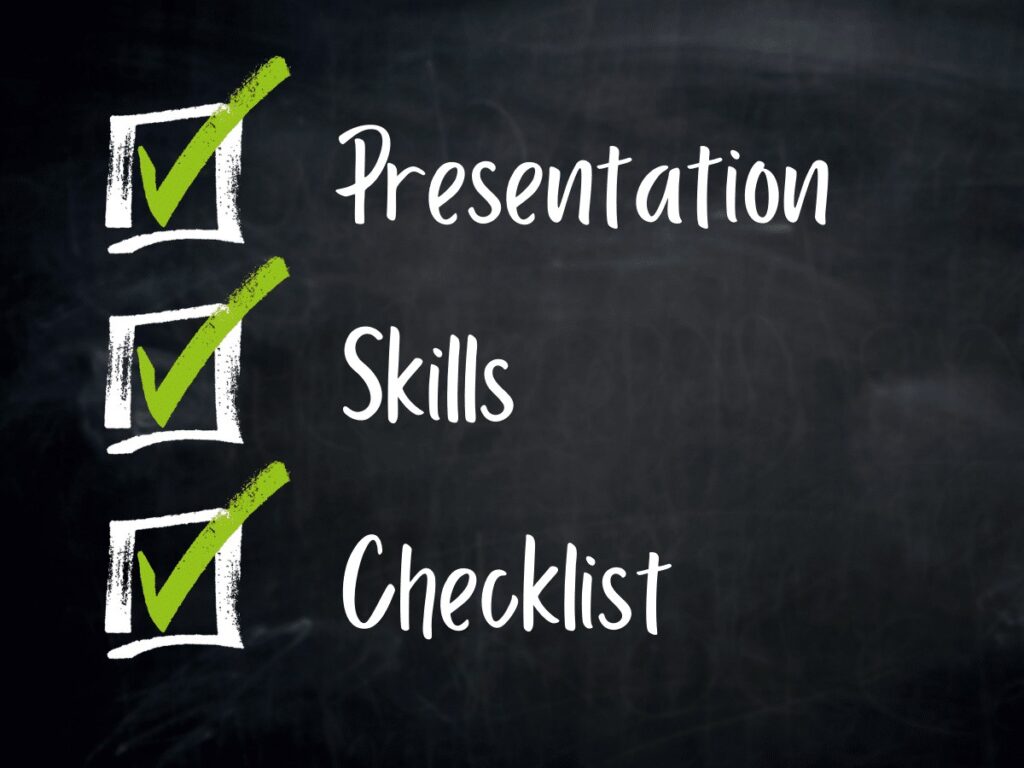
Before pilots take a plane off the ground, they always follow a written checklist. They don’t follow this process by memory. Instead, they check off each task one by one.
There is a reason why every pilot does this. The process takes a tremendous amount of risk out of the equation. The checklist also takes something very complex and makes it very simple.
Great presenters do the same thing. If you follow a simple presentation checklist, you make delivering the presentation less risky.
In my classes, I teach students how to design an entire presentation, from start to finish, in fifteen minutes or less. These class members are often shocked at how fast they can design their presentations. They finish in minutes what would have typically taken hours (or weeks) to complete.
Below is this simple presentation checklist that you can use when you design PowerPoint presentations. It will help you shorten your preparation time and also reduce your fear of public speaking.
Presentation Skills Checklist
#1: Start by Thinking About What Your Audience Really Wants or Needs to Know About the Topic.

Instead, ask yourself this question. “What does my audience really need to know?” Or, “How can I help the audience understand this topic better?”
Put yourself in the shoes of the person sitting in your audience. What problems or challenges is this person facing that your knowledge will help him or she overcome? Before you design a slide or create any bullet points, make sure to follow step #1 in this presentation skills checklist. If you skip it, your presentation can go off the rails quickly.
Years ago, I was helping an engineering firm design a presentation for a potential client. Their goal was to get this big client to hire them. Before I started working with them, they had already created a rough draft of their talking points. They wanted to start by telling the potential customer about their experience. In fact, they designed the entire presentation around how great they were.
The problem, though, was that the content was great to stroke the ego of the presenters. It was not helpful to the audience, though. I suggested they focus more on the engineering challenges that the client was experiencing. Then, show the client how they could make those challenges go away. (The process created a much more effective presentation.)
For additional details see Make Your Presentation “Audience Focused”.
#2: Create a Compelling Title (Topic).

A compelling topic has two parts. Part one is a specific line of information that the audience needs or wants. Then, part two is a benefit to the audience if they understand this information.
A Compelling Title Contains Specific Information that the Audience Needs to Know.
For instance, let’s say that you are giving a project report. Most project managers will just give their presentation a generic title like… well… “Project Report.” However, that give the audience no information. It also gives the audience no reason to pay attention. (It is completely uninteresting.) So, the project manager is behind the eight ball before he or she even begins to speak.
Instead, this manager can think about what important things have happened since the last report. Then summarize that information in the first part of the title. For instance, perhaps in previous reports, materials may have been delayed. As a result, the project was behind schedule. However, this month, the team got back on schedule.
In this instance, the original title, “Project Report,” becomes “The Project Is Now Back on Schedule.”
If you think about it, you’d have a tough time delivering a presentation on the original topic. The project may have thousands of component parts. And most of the parts are of no interest to the audience. However, if we focus on just the fact that we got back on schedule, the presenter will have an easier time. He or she could just tell about the things we did to get back on schedule.
A Compelling Title Contains a Benefit to the Audience.
The second part of the title should have a benefit or advantage to the audience. For this part, pretend like you are in your audience. Why would you even care about what is going to be said? If the answer is, “I wouldn’t,” then skip the speech. You are wasting everyone’s time.
Going back to the project report example, getting back on schedule will likely keep us from incurring penalties.
Now you have both parts. The compelling title would be, “The Project Is Now Back on Schedule, So We Will Likely Not Incur Delay Penalties.”
This one is much more interesting than “Project Report.”
For additional details see Catchy Presentation Titles.
#3: Choose Three to Five Key Points to Expand Upon.

Speakers fall into the trap because we think that if we don’t tell the audience everything, we will have failed as a speaker. The opposite is more true, though. Most audience members don’t want you to waste their time telling them a bunch of crap they really don’t care about.
Instead, you want to design your bullet points by just identifying a few key, most important points.
Think about your new topic. List out just the most important things that the audience needs to know that will also help them get the benefit. Going back to the example, what were the most important things we did that got us back on schedule? Which of these things were most helpful in helping us not incur penalties?
Just make a list. Then, go back and rank each in the order of their importance. You may end up with a lengthy list or it might be very small. Either way, though, in a single sitting, the audience will only be able to retain three to five main points. So, if you are just delivering a single speech, just focus on the top five items. If you cover more points, the audience won’t remember them anyway, so focus on the most important points.
These items now become your bullet points.
For additional details see Design Better Bullet Points.
#4: Insert Proof for each Point.

Step four in the Presentation Skills Checklist is to now prove that each of your bullet points is true. Pretend like you are an attorney, and you are making a case to the jury. Your bullet points are your accusations. Now, you have to prove these items are true.
Insert a few stories, examples, facts, analogies, demonstrations, or samples that prove that your key point is true.
The project manager telling about getting back on schedule could easily prove each point with just stories. All he or she has to do is just explain in a little detail how each of those things occurred.
One of the ways we got back on schedule was to order additional materials and store them on site. For instance, on past projects, when materials were in stock, we ordered them on an as-needed basis. This time, though, we had to wait four weeks to get flooring for building one. So, we just ordered enough flooring for all four buildings, and we are now storing the flooring in the completed building one.
If you prove each point along the way, then the group will very easily agree with your conclusion at the end of the presentation.
For additional details see Add Impact to Any Presentation.
$5: The Final Step in the Presentation Skills Checklist Is to Create Your Slideshow.

The absolute biggest mistake that most presenters make is starting the process by designing their slideshow. They use the visual aid creation as a brainstorming session. The hope is that they will create a fantastic slideshow that will Wow! the audience. Then, the words will come much easier because the pressure is off.
This never happens, by the way. Instead, you will end up with a series of unconnected data points and thoughts. You’ll then spend a LOT of time trying to connect everything together into a cohesive message.
Eventually, though, these folks realize they have too many slides or too many points and start cutting content. So they end up with a Swiss-Cheese presentation. This will make your message even harder to deliver.
Once you have the speech designed, now go back and choose visual aids to better explain your content.
For additional details see 7 of the Best PowerPoint Tips.
Follow this checklist, and you will be able to create any presentation very quickly.
